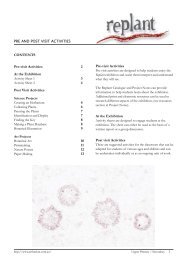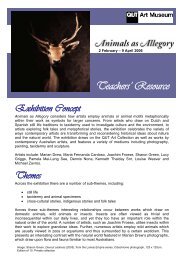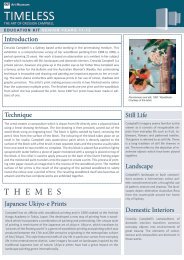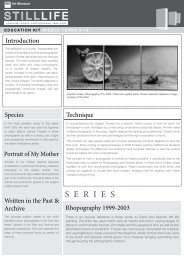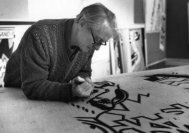Clifton Pugh - QUT Art Museum
Clifton Pugh - QUT Art Museum
Clifton Pugh - QUT Art Museum
You also want an ePaper? Increase the reach of your titles
YUMPU automatically turns print PDFs into web optimized ePapers that Google loves.
<strong>Clifton</strong> <strong>Pugh</strong> PRINTMAKER<br />
Page 26<br />
Exploring and Responding<br />
<strong>Art</strong> Trail<br />
A favourite motif of <strong>Pugh</strong>’s is the bird. Birds feature in a number of works in this exhibition,<br />
how many can you spot? Which birds do you recognise? Are any of these birds found<br />
in your local area? What differences lie between these birds? Create a table with your<br />
discoveries and share this with the group.<br />
The World’s Longest fence<br />
Australia is home to the world’s longest fence built in the 1880s to keep dingos out<br />
of areas where farmers were housing sheep. The fence has had limited success in<br />
controlling the dingo population, as seen first hand, and mentioned by <strong>Pugh</strong> in his<br />
quote above. Which three states of Australia house the fence?<br />
After the bushland area of Dunmoochin, the outback landscape of Tibooburra was of<br />
particular fascination to <strong>Pugh</strong>. Situated in Corner Country, alongside the Dingo fence<br />
<strong>Pugh</strong> spent many years visiting the area. In a number of these works <strong>Pugh</strong> has employed<br />
a palette of iridescent orange. Discuss your opinion of the artist’s intention here and the<br />
subject matter he focuses on. Research this part of Australia, its native flora, fauna, the<br />
origin of its name and explorer history. With your research create a tourist brochure or<br />
imagined Tibooburra website homepage with information to attract visitors to the area.<br />
Manindi – A special dingo<br />
Jean A Ellis has compiled a series of Australian Aboriginal legends in her anthology,<br />
This is the Dreaming taken from the rich oral history Aboriginal people refer to as the<br />
Dreaming. In the tale below of Manindi, told by the Ngauri and Piladapa people, we<br />
discover the significance of the colour red and the reason they believed there to be<br />
an abundance of ochre in their area, where the New South Wales and South Australian<br />
borders meet.<br />
In the early days of Aboriginal history, a giant lizard, one of dinosaur proportions, lived<br />
in the Flinders Ranges and preyed upon the unfortunate people. Many brave hunters<br />
attempted to protect their people but nothing seemed to baulk or worry the massive<br />
creature. At this time the Ngauri people had a pet dingo which they had named<br />
Manindi. They had found Manindi as a pup and raised him. Though he now roamed<br />
free, he remained their faithful friend. One day the giant, marauding lizard approached<br />
a peaceful campsite, planning yet again to drag away some of the defenceless people.<br />
Manindi saw the beast approaching. He was afraid, but he steeled himself to fight to<br />
the death to save the people. Manindi walked to the edge of the campsite and attacked<br />
the surprised lizard. He was no match in size for the ferocious lizard and very<br />
determined to defend his people.


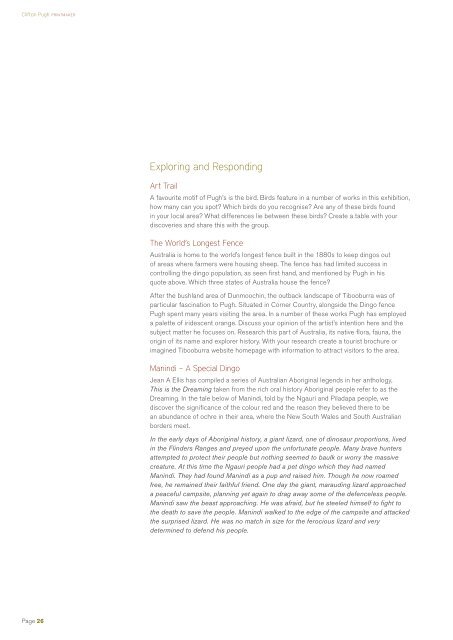

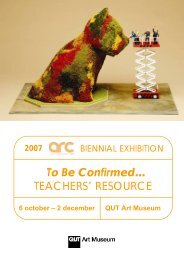

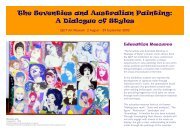
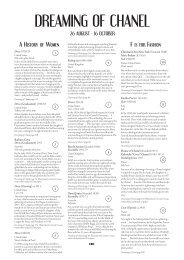
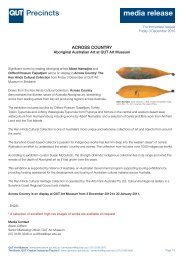
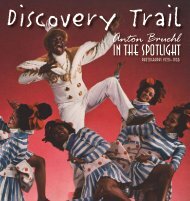

![Senior Years (10-12) [pdf - 4.5 MB] - QUT Art Museum](https://img.yumpu.com/38225334/1/184x260/senior-years-10-12-pdf-45-mb-qut-art-museum.jpg?quality=85)
